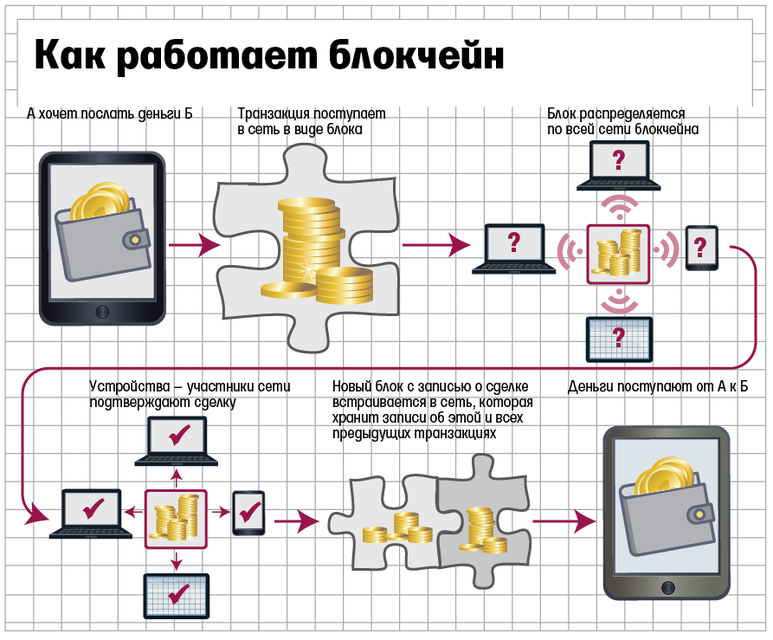Russian authorities are one step away from the introduction of the blockchain

In March, Prime Minister Dmitry Medvedev suggested that the Ministry of Economic Development and the Ministry of Communications should think about how to defeat the bureaucracy with the help of blockchain technology, and in mid-May called for discussing the legal regulation of the blockchain. According to the forecast of consulting company Accenture, in 2018-2024 the blockchain will be distributed to many types of assets, and by 2025 this technology will become a mass and integral part of global capital, Vedomosti reports.
The technology has gained great fame due to its connection with the Bitcoin cryptocurrency. However, now without Bitcoin she lives well.
Blockchain is a decentralized database based on a peer-to-peer (p2p) network, a common registry, and public and private key cryptography. Having entered the blockchain network, the user connects to other computers on the network in order to exchange data with them: blocks and records. After receiving new data, each user checks their correctness, and, after verifying the reliability, keeps them at home, and also transmits the correct data further through the network.Microsoft technical evangelist Konstantin Goldstein believes that the main consumer of blockchain is the financial sector: he needs increased protection for online payments, which decentralized technology can provide. Blockchain also has prospects for use in the healthcare, insurance, retail, real estate, property registration and music industry.
Yuri Mazurov, deputy head of the commercial directorate for integrator Asteros, complements the list with such a broad direction as the protection of legal rights.
The blockchain is useful where there is a need for complex asset transfers with the confirmation of a large number of parties where inter-agency cooperation is needed, Alexey Arkhipov from the Association for the Development of Financial Technologies summarizes.
Implementation
To introduce the blockchain, you do not need to purchase special equipment or create non-trivial software solutions, explains Maxim Azrilian, chief technical architect of Alfa Bank. According to him, the development of the blockchain on the basis of the open source code is available to anyone and their use does not pose much difficulty.
One of these software solutions is Ethereum, a blockchain platform popular all over the world. It is used in its own service, Microsoft Azure Blockchain as a Service (BaaS), where you can deploy blockchain infrastructure in one click, explains Mazurov. BaaS uses several blockchain solutions: Ethereum, Chain Core, Corda, Nxt, Lisk, Waves, he lists.
IBM has a Blockchain for Hyperledger Fabric solution, which is being tested by a number of banks and companies, a representative of the American corporation told Vedomosti. According to him, it does not require significant improvements for the customer.
Earlier, the Central Bank together with the largest banks launched a masterpiece platform that allows you to make online payments, promptly confirm the relevance of customer or transaction data, and quickly create financial services. This platform is built on Ethereum and Russian cryptography, explains Arkhipov of the Association for the Development of Financial Technologies.
Not one "but"
While insufficiently developed mechanisms for data distribution and access control to them, which can lead to loss of control over confidential information.
There are no uniform requirements for the identification of network participants and responsibility for the quality of the data they upload.
There is no judicial practice on transactions based on the blockchain, summarizes the representative of the Ministry of Communications.
If the bank has a standard remittance - changing numbers on two accounts, in the blockchain system it is a calculation of a complex mathematical function, said Anatoly Orlov, head of the big data laboratory of the Internet Initiatives Development Fund (IIDF).
Standard payment systems pass up to 45,000 transactions per second, and the blockchain cannot boast of such speeds: it is capable of no more than 3-4 transactions per second, says Alimbekov, director of technological development of the IIDF.
The massive use of information technology blockchain in Russia requires changes in legislation and can begin no earlier than in a year or two, and it can take about ten years to understand it, says the head of Sberbank German Gref.
The use of the blockchain in Russia will require an adjustment of the Federal Law “On Personal Data”.
“Obviously, this is one of the breakthrough technologies, and it will greatly change all sectors, starting with ours, but for now this is the technology of the future. It is necessary to adjust the legislation for it, because there are a large number of features. The current law on personal data has limitations in the use of this technology, ”concluded Gref.
At the same time, the head of the working group of the Central Bank of the Russian Federation on cryptocurrency Elina Sidorenko is confident that products produced using the blockchain should be introduced into the legal field, but the technology itself should remain outside the legal framework.
In the West, the authorities' interest in the blockchain is much stronger and appeared much earlier. In October 2015, the UK government announced that it would allocate £ 10 million to explore the potential of a distributed registry. And then the Bank of England took the initiative to create a roadmap to modernize the financial infrastructure of the country with the possible use of distributed registry technology.
All Articles